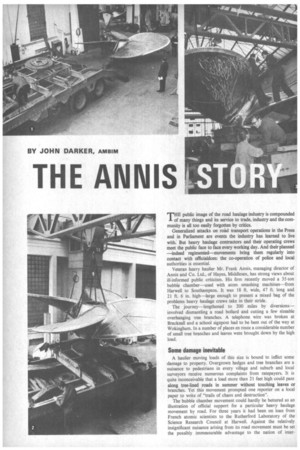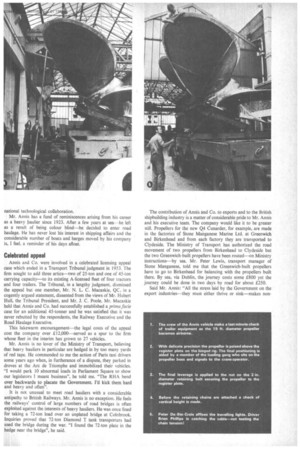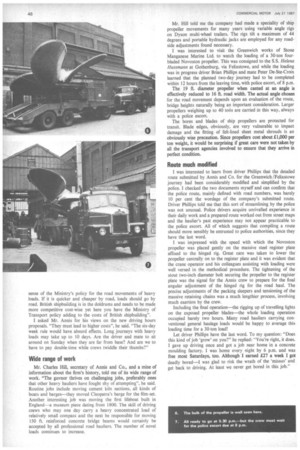THE ANNIS
Page 46

Page 47

Page 48

If you've noticed an error in this article please click here to report it so we can fix it.
THE public image of the road haulage industry is compounded of many things and its service to trade, industry and the community is all too easily forgotten by critics.
Generalized attacks on road transport operations in the Press and in Parliament are events the industry has learned to live with. But heavy haulage contractors and their operating crews meet the public face to face every working day. And their planned —indeed regimented—movements bring them regularly into contact with officialdom: the co-operation of police and local authorities is essential.
Veteran heavy haulier Mr. Frank Annis, managing director of Annis and Co. Ltd., of Hayes, Middlesex, has strong views about ill-informed public criticism. His firm recently moved a 35-ton bubble chamber used with atom smashing machines—from Harwell to Southampton. It was 18 ft. wide, 47 ft. long and 21 ft. 6 in. high—large enough to present a mixed bag of the problems heavy haulage crews take in their stride.
The journey—lengthened to 200 miles by diversions— involved dismantling a road bollard and cutting a few sizeable overhanging tree branches. A telephone wire was broken at Bracknell and a school signpost had to be bent out of the way at Wokingham. In a number of places en route a considerable number of small tree branches and leaves were brought down by the high load.
Some damage inevitable
A haulier moving loads of this size is bound to inflict some damage to property. Overgrown hedges and tree branches are a nuisance to pedestrians in every village and suburb and local surveyors receive numerous complaints from ratepayers. It is quite inconceivable that a load more than 21 feet high could pass along tree-lined roads in summer without touching leaves or branches. Yet this movement prompted one reporter on a local paper to write of "trails of chaos and destruction".
The bubble chamber movement could hardly be bettered as an illustration of official support for a particular heavy haulage movement by road. For three years it had been on loan from French atomic scientists to the Rutherford Laboratory of the Science Research Council at Harwell. Against the relatively insignificant nuisance arising from its road movement must be set the possibly immeasurable advantage to the nation of inter national technological collaboration.
Mr. Annis has a fund of reminiscences arising from his career as a heavy baulier since 1923. After a few years at sea—he left as a result of being colour blind—he decided to enter road haulage. He has never lost his interest in shipping affairs and the considerable number of boats and barges moved by his company is, I feel, a reminder of his days afloat.
Celebrated appeal Annis and Co. were involved in a celebrated licensing appeal case which ended in a Transport Tribunal judgment in 1953. The firm sought to add three artics—two of 25-ton and one of 45-ton carrying capacity—to its existing A-licensed fleet of four tractors and four trailers. The Tribunal, in a lengthy judgment, dismissed the appeal but one member, Mr. N. L. C. Macaskie, QC, in a cogently argued statement, dissented from the views of Mr. Hubert Hull, the Tribunal President, and Mr. T. C. Poole. Mr. Macaskie held that Annis and Co. had successfully established a prima facie case for an additional 45-tormer and he was satisfied that it was never rebutted by the respondents, the Railway Executive and the Road Haulage Executive.
This lukewarm encouragement—the legal costs of the appeal cost the company over £12,000 served as a spur to the firm whose fleet in the interim has grown to 27 vehicles.
Mr. Annis is no lover of the Ministry of Transport, believing that heavy hauliers in particular are hedged in by too many yards of red tape. He commended to me the action of Paris taxi drivers some years ago when, in furtherance of a dispute, they parked in droves at the Arc de Triomphe and immobilized their vehicles.
"I would park 10 abnormal loads in Parliament Square to show our legislators I meant business", he told me. "The RHA bend over backwards to placate the Government. I'd kick them hard and heavy and often".
It is not unusual to meet road hauliers with a considerable antipathy to British Railways. Mr. Annis is no exception. He feels the railways' control of large numbers of road bridges is often exploited against the interests of heavy hauliers. He was once fined for taking a 72-ton load over an unplated bridge at Colnbrook. Inquiries proved that 72-ton Diamond T tank transporters had used the bridge during the war. "I found the 72-ton plate in the hedge near the bridge", he said.
The contribution of Annis and Co. to exports and to the British shipbuilding industry is a matter of considerable pride to Mr. Annis and his executive team. The company would like it to be greater still, Propellers for the new Qfl Cunarder, for example, are made in the factories of Stone Manganese Marine Ltd. at Greenwich and Birkenhead and from each factory they are transported to Clydeside. The Ministry of Transport has authorized the road movement of two propellers from Birkenhead to Clydeside but the two Greenwich-built propellers have been routed—on Ministry instructions—by sea. Mr. Peter Lewis, transport manager of Stone Manganese, told me that the Greenwich-built propellers have to go to Birkenhead for balancing with the propellers built there. By sea, via Dublin, the journey costs some £800 yet the journey could be done in two days by road for about £250.
Said Mr. Annis: "All the stress laid by the Government on the export industries—they must either thrive or sink—makes non sense of the Ministry's policy for the road movements of heavy loads. If it is quicker and cheaper by road, loads should go by road. British shipbuilding is in the doldrums and needs to be made more competitive cost-wise yet here you have the Ministry of Transport policy adding to the costs of British shipbuilding".
I asked Mr. Annis for his views on the new driving hours proposals. "They must lead to higher costs", he said. "The six-day week rule would have absurd effects. Long journeys with heavy loads may take up to 10 days. Are the driver and mate to sit around on Sunday when they are far from base? And are we to have to pay double-time while crews twiddle their thumbs?"
Wide range of work Mr. Charles Hill, secretary of Annis and Co., and a mine of information about the firm's history, told me of its wide range of work. "The guvnor thrives on challenging jobs, preferably ones that other heavy hauliers have fought shy of attempting", he said. Routine jobs include moving cement kiln sections, all kinds of boats and barges—they moved Cleopatra's barge for the film-set. Another interesting job was moving the first lifeboat built in England—a museum piece dating from 1800. The skill of driving crews who may one day carry a heavy concentrated load of relatively small compass and the next be responsible for moving 150 ft. reinforced concrete bridge beams would certainly be accepted by all professional road hauliers. The number of novel loads continues to increase.
Mr. Hill told me the company had made a speciality of ship propeller movements for many years using variable angle rigs on Dyson multi-wheel trailers. The rigs tilt a maximum of 44 degrees and portable hydraulic jacks are employed for any roadside adjustments found necessary.
I was interested to visit the Greenwich works of Stone Manganese Marine Ltd. to watch the loading of a 30-ton fourbladed Novoston propeller. This was consigned to the S.S. Helena Hussmann at Gothenburg, via Felixstowe, and while the loading was in progress driver Brian Phillips and mate Peter De-Ste-Croix learned that the planned two-day journey had to be completed within 12 hours from the leaving time, with police escort, of 8 p.m.
The 19 ft. diameter propeller when canted at an angle is effectively reduced to 16 ft. road width. The actual angle chosen for the road movement depends upon an evaluation of the route, bridge heights naturally being an important consideration. Larger propellers weighing up to 40 tons are carried in this way, always with a police escort.
The bores and blades of ship propellers are protected for transit. Blade edges, obviously, are very vulnerable to impact damage and the fitting of felt-lined sheet metal shrouds is an obviously wise precaution. Since propellers cost about £1,000 per ton weight, it would be surprising if great care were not taken by all the transport agencies involved to ensure that they arrive in perfect condition.
Route much modified I was interested to learn from driver Phillips that the detailed route submitted by Annis and Co. for the Greenwich /Felixstowe journey had been considerably modified and simplified by the police. I checked the two documents myself and can confirm that the police route, mainly defined with road numbers, was barely 10 per cent the wordage of the company's submitted route. Driver Phillips told me that this sort of streamlining by the police was not unusual. Police drivers acquire unrivalled experience in their daily work and a prepared route worked out from street maps and the haulier's past experience may not appear practicable to the police escort. All of which suggests that compiling a route should more sensibly be entrusted to police authorities, since they have the last word.
I was impressed with the speed with which the Novoston propeller was placed gently on the massive steel register plate affixed to the hinged rig. Great care was taken to lower the propeller centrally on to the register plate and it was evident that the crane operator and his colleagues assisting with loading were well versed in the methodical procedure. The tightening of the stout two-inch diameter bolt securing the propeller to the register plate was the signal for the Annis crew to prepare for the final angular adjustment of the hinged rig for the road haul. The precise adjustments of the packing sleepers and tensioning of the massive retaining chains was a much lengthier process, involving much exertion by the crew.
Including the final operation—the rigging up of travelling lights on the exposed propeller blades—the whole loading operation occupied barely two hours. Many road hauliers carrying conventional general haulage loads would be happy to average this loading time for a 30-ton load!
Let driver Phillips have the last word. To my question: "Does this kind of job 'grow' on you?" he replied: "You're right, it does.
I gave up driving once and got a job near home in a concrete moulding factory. I was home every night by 6 p.m. and was free most Saturdays, too. Although I earned £27 a week I got deadly bored—I was glad to risk the wrath of the 'missus' and get back to driving. At least we never get bored in this job."












































































































